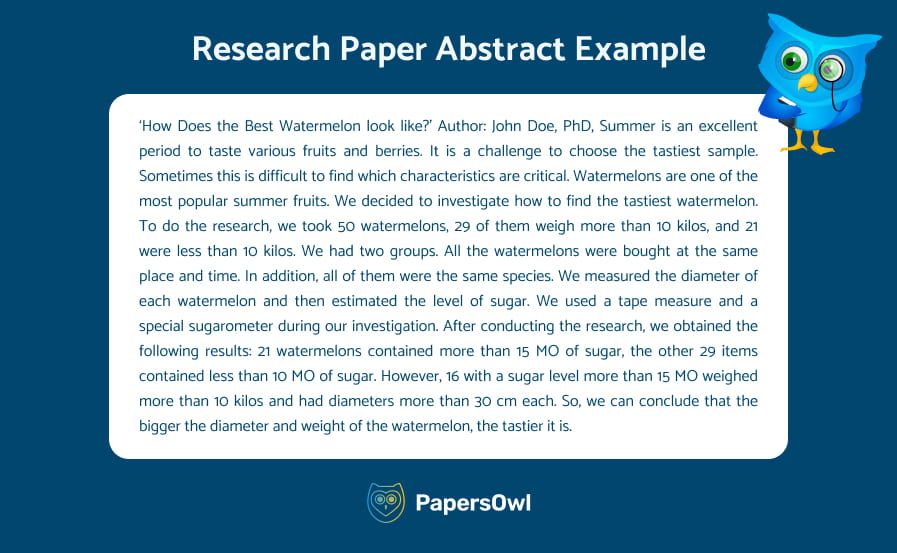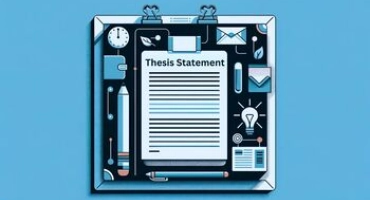How to Write an Abstract for a Research: Research Paper’s Core in Brief
Table of contents
An abstract section of a research paper is needed to explain the main points of your research. There are many frameworks and helpful advice on how to write it on the Internet. However, requirements can also be clarified by your professors or tutors, who will review the work afterward.
This article will provide the following information:
- An abstract definition in research and its significance as a short version of an academic paper.
- An easy-to-use guide on how to write an abstract and what should an abstract include.
- The essentials for writing a research paper to check before composing the first draft.
- The main parts of abstract writing, such as background, methods, results, and conclusion.
- Common pitfalls to avoid when writing a good abstract.
Wondering how to start an abstract? Let’s go over the importance of crafting a decent abstract for a research paper!
Understanding the Significance of an Abstract
What is an abstract? It is a condensed version of the research manuscript that aims to represent the paper efficiently.
The abstract is critical in interpreting the ideas outlined at the start of the proposal. Additionally, a research paper abstract serves as a condensed gateway to a larger body of work. Although it offers a snapshot of the main concepts, methodology, and findings, the abstract is just a glimpse into the bigger picture. For assistance in crafting a precise and impactful abstract, a research paper writing service can provide expert guidance.
A paper abstract demands analytical expertise to extract the meanings, acting as a compass for readers. Hence, an intellectual lens sharpens focus and aids in efficient knowledge acquisition.
Why and When to Write an Abstract?
Writing an abstract is essential for succinctly conveying your message, whether it is a research paper, article, or presentation. Thus, it is a concise summary, encapsulating the core objectives, methodology, results, and conclusions.
A well-crafted research abstract provides a quick overview, helping readers decide to delve deeper into the work. It is especially essential in academic and professional settings. Besides, it facilitates efficient information retrieval and aids in academic databases.
Writing an abstract for a research proposal is a strategic move before conferences, submissions, or publications, enhancing the visibility and accessibility of one’s work. Timely, clear, engaging abstracts contribute significantly to effective communication and knowledge dissemination.
Types of Academic Paper Abstracts
In general, there are two main types of abstract for thesis:
- Descriptive abstract sample: outlines the fundamental aspects of a study, summarizing its key components without delving into specific findings. It provides a brief overview of the research question, methodology, and main conclusions, acting as a teaser for the full paper.
- Informative abstract sample: provides a snapshot of the entire research process, enabling readers to grasp the essence and significance without delving into the complete document. Both styles are pivotal in catering to diverse readerships and serve different purposes in academic discourse.
If the complexity of the full study makes summarizing difficult, students sometimes choose to pay for research paper writing assistance to ensure all components, including the abstract, are perfect.
By understanding the purpose and structure of a research paper and developing clear and concise thoughts, you can create a compelling abstract for a research paper.
It is critical to note that an abstract of a paper should be a concise description of the research article and provide key information to the reader to help them understand the core of the paper.
The Structure of an Academic Paper Abstract
People who ask: how to write an abstract for a research paper should familiarize themselves with these abstract guidelines:
- In the short version. The size of this document may well not exceed half of a standard sheet. It is often enough to describe the research methodology and indicate the goals that were set.
- In the extended version. In this case, the document size should be from 1-2 to 3-4 sheets. Here, you should indicate the main information and your feedback about all the essential and significant points in the research.
Title
An abstract title should be descriptive and accurate. When you write an abstract, include information about the relevant author and underline their scholarly achievements.
You should be mindful of technical requirements such as capitalized letters and font size. Meanwhile, the title should pique the reader’s interest and be engaging.
Introduction
Begin the introduction with the analysis’s facts. A solid abstract example should describe the problem’s significance and your genuine approach to finding a solution. Thus, the opening sentence of the introduction must catch the reader’s attention.
Objectives
Provide an extensive overview of the problem you attempt to solve when you write an abstract for a research paper. Describe the project’s scope and discuss the thesis for abstract, primary arguments, and claims.
Methodology
The research paper methods section answers the following questions:
- What was the research design?
- What was the sample size in the different groups?
- What was the duration of the abstract study?
- What was the primary outcome measure, and how was it defined?
Results
Don’t miss the results inquiry in the abstract of the research paper. Try to put ideas first, not the whole research process. Accordingly, include only important findings which might correlate with the readers’ viewpoints.
Conclusion
The major part of an abstract format is where you have to summarize the synopsis in a few sentences. You can just make it as a thesis without an explanation.
The proper research paper format can be a game-changer for academic publication. Whether it’s an MLA format abstract or a Chicago style abstract, make sure to include the specific details and create an abstract of appropriate length.
Keywords
There are two main purposes of keywords. First, researchers use them to activate keyword index searches. Second, keywords help assign papers to review committees or editors.
Ensure that the keywords you pick make assigning your paper to a review category obvious.
Common Pitfalls When Writing Abstract Research Paper
Common pitfalls in writing an abstract for a research paper include excessive jargon, vague language, and neglecting to summarize key results. Additionally, abstracts should avoid being too lengthy or omitting crucial information.
Lack of clarity about the research question and overemphasizing background details can also hinder their effectiveness, diminishing the overall impact of the abstract of the study.
Excessive Length
Excessive abstract length is a common pitfall in academic writing. If you’re struggling with how long the abstract should be, condense your research into the recommended 150-250 words. This verbosity can deter readers, overshadowing key points. Hence, achieving brevity without sacrificing content is crucial.
You don’t want to repeat yourself or reveal the importance of research in advance. It makes writing a dissertation and thesis deceptively difficult because the abstract structure has to convey a lot of information in a limited space. If done well, it makes the reader want to learn more about your research.
Lack of Clarity
Lack of clarity poses another challenge, where the abstract in a research paper may be overly technical or vague. A balance must be hit between providing sufficient detail for comprehension and avoiding unnecessary complexity, ensuring accessibility to a broader audience.
If you want the text to be fully understood, clarity is crucial. Thus, it is best to avoid using dense, overbearing language that obscures the author’s main points in favor of writing clearly and directly. Besides, it is ideal to use the active voice to make sense.
Including references
The inclusion of references in the abstract of a dissertation is discouraged, as it adds unnecessary bulk and contradicts the summary’s concise nature. Instead, references should be reserved for the main body of the paper.
References in the thesis abstract may highlight important information related to your findings. Therefore, it’s better to avoid including references at the very beginning. Tell the premise, but don’t reveal the whole story.
Overusing Jargon and Abbreviations
Overusing jargon and abbreviations alienates readers unfamiliar with specialized terms. Striking a balance between technical precision and accessibility is vital for effective communication.
Unless an acronym or abbreviation is widely known or is used repeatedly in the abstract, it is preferable to refrain from using them in a dissertation abstract. Overusing them can make the material harder to read, particularly for non-specialist readers. Consequently, they would have to turn pages to find the original definition, quickly losing interest.
Lack of Engagement
A lack of engagement in abstracts can result from a dry, detached tone. Authors should infuse enthusiasm and relevance to captivate readers, conveying the significance of their work and encouraging further exploration.
Including the public in the abstract of a research paper can provide new insights in several ways. For instance, it can challenge preconceived notions about your methodology and help you formulate your research questions.
Failing to Reflect on the Paper
Bad examples of the abstract fail to reflect the main contributions of research. A well-crafted abstract should accurately encapsulate the study’s objectives, methods, results, and conclusions, offering a comprehensive preview without misleading interpretations.
In essence, the abstracted outline should be your entire paper in a pretty package that your readers can easily read and understand the topic of the entire research paper. It indicates that one of the academics’ biggest and most frequent errors is failing to state their conclusion.
Research Paper Abstract Example

Learn the Basics of Abstract
Although you place an abstract at the beginning, it should be the last thing to write. An abstract is a concise summary of your thoughts, with the main mission of drawing attention to your research.
An abstract outline should include a reason for writing, the main problem, and the methodology of your study. You may look up abstract examples that are similar to your research model.
If you feel confused about the structure of an abstract and don’t know how to formulate your thoughts and ideas, let professional essay writers help you from PapersOwl! We’ll help detail your study in a few sentences without overwhelming your readers.






